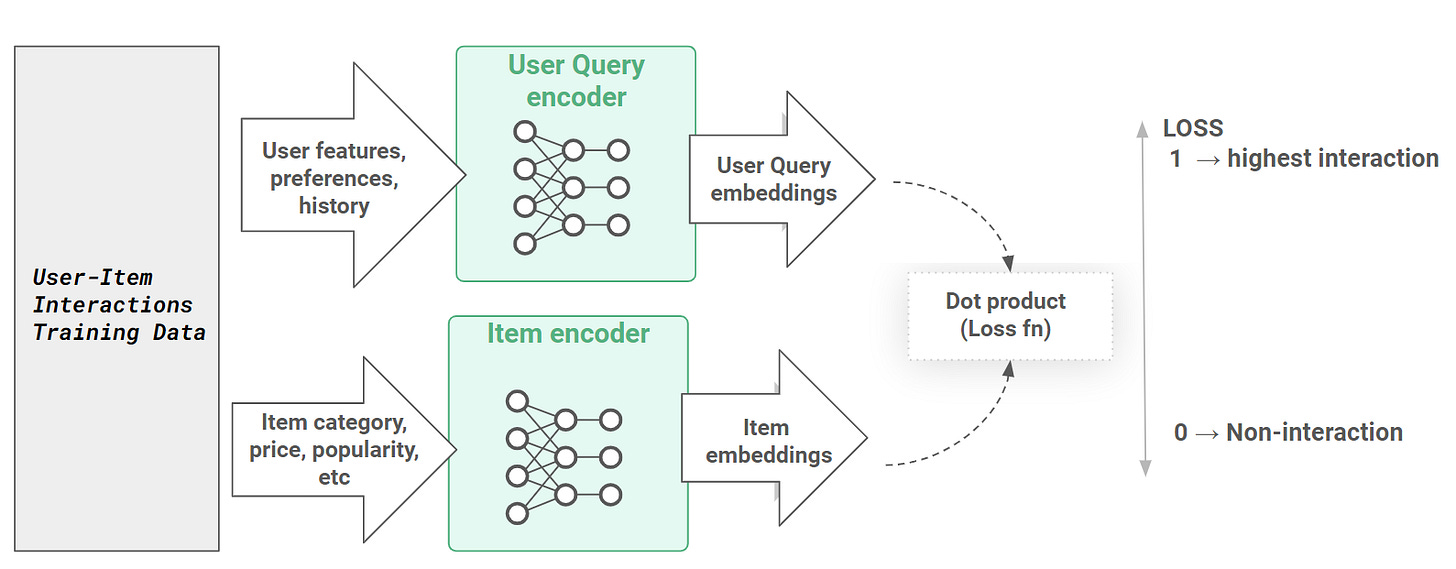Building a Two-Tower Search Query Retrieval Model: A Practical Guide
Two-Tower models provide a powerful, scalable approach to retrieval tasks in recommendation systems.
In today's data-driven world, recommendation systems play a crucial role in enhancing user experience across various platforms. Whether it's e-commerce websites suggesting products, social media platforms recommending content, or search engines retrieving relevant information, the underlying technology often relies on sophisticated retrieval models. One such powerful architecture is the Two-Tower model, which has gained significant popularity for its scalability and effectiveness.
What Are Two-Tower Models?
Two-Tower models are deep learning architectures specifically designed for retrieval tasks in recommendation systems. As the name suggests, they consist of two separate neural network "towers":
Query Tower: Processes user queries or user information
Item Tower: Processes item information (products, documents, videos, etc.)
Each tower independently transforms its inputs into embeddings (dense vector representations), which are then compared using similarity metrics to determine relevance.
Versatility of Two-Tower Models
The beauty of Two-Tower models lies in their versatility. The two towers can represent various entity pairs:
Query-Product: In e-commerce (search for shoes, get relevant footwear)
Query-Document: In knowledge bases (search Wikipedia, get relevant articles)
Query-Person: In professional networks (search LinkedIn, find relevant profiles)
User-Product: For personalized product recommendations
User-Content: For personalized content feeds (Instagram, YouTube)
User-User: For friend/connection recommendations (LinkedIn, Twitter)
Why Companies Use Two-Tower Models at Scale
Efficiency and Scalability
Two-Tower models offer significant advantages for large-scale applications:
Offline Computation: Item embeddings can be pre-computed and stored, reducing real-time computation needs.
Fast Retrieval: When a user submits a query, only the query embedding needs to be computed in real-time.
Approximate Nearest Neighbor (ANN) Search: Fast similarity search techniques can quickly find the most relevant items from millions of options.
Generalization Capability
Neural networks can generate meaningful embeddings even for items or queries not seen during training, allowing the system to handle new items gracefully.
Implementing a Two-Tower Model: A Practical Approach
Let's walk through the implementation of a basic Two-Tower model using the Amazon search query dataset.
The Dataset
We'll use the Amazon search query dataset, which contains:
Queries (what users searched for)
Products (items in the catalog)
Relevance labels (exact match, substitute, complement, irrelevant)
Product features (title, description, bullet points, brand, color)
Model Architecture
Our Two-Tower model will consist of:
Query Tower:
Takes query text as input
Converts it to embeddings using a pre-trained model
Passes through dense layers to create a condensed representation
Product Tower:
Takes product features as input (title, description, bullet points, brand, color)
Converts each feature to embeddings
Concatenates these embeddings
Passes through dense layers to create a condensed representation
Similarity Computation:
L2 normalization of both tower outputs
Dot product computation (equivalent to cosine similarity after normalization)
Binary cross-entropy loss for training
Implementation Steps
Data Preparation:
Convert all text to lowercase
Handle missing values
Generate embeddings for queries and product features using a pre-trained Sentence Transformer model
Model Definition:
Define input layers for query and product features
Create dense layers to condense the embeddings (from 768 to 16 dimensions)
Add L2 normalization layers
Compute dot product for similarity
Training:
Use binary cross-entropy loss
Treat exact matches as positive examples (label 1)
Treat irrelevant matches as negative examples (label 0)
Implement model checkpointing to save the best model
Inference:
Extract the normalized query and product embeddings
Perform approximate nearest neighbor search to find relevant items for new queries
Testing the Model
After training, we can test our model with new queries like:
"Red dress for wedding"
"Best laptop"
"Nike running shoes"
"iPhone 13"
The model successfully retrieves relevant products, such as:
Wedding dresses and accessories for "Red dress for wedding"
Nike women's running shoes for "Nike running shoes"
Wireless chargers for "charger for smartphone"
Potential Improvements
While our basic implementation works well, several enhancements could improve performance:
Additional Features:
Include numerical features like price, ratings, and reviews
Add query-specific features like query length and popularity
Larger Training Dataset:
Training on more examples would improve embedding quality
Advanced Techniques:
Implement adaptive mimic mechanisms
Add category alignment loss
Explore personalization options based on user behavior
Conclusion
Two-Tower models provide a powerful, scalable approach to retrieval tasks in recommendation systems. By learning meaningful embeddings for both queries and items, these models can efficiently retrieve relevant results from massive catalogs in real-time.
The implementation we've explored demonstrates how to build a basic Two-Tower model from scratch, but there's significant room for customization and improvement based on specific use cases and requirements.
Whether you're building a search system, a recommendation engine, or any application requiring efficient retrieval from large datasets, the Two-Tower architecture offers a solid foundation to build upon.
Happy modeling!
Have you implemented recommendation systems before? What challenges did you face? Share your experiences in the comments below!




